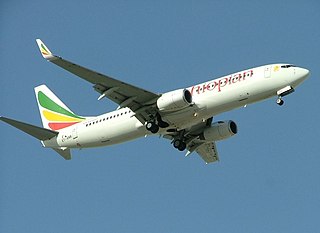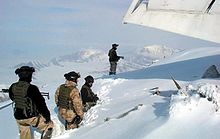
Kabul International Airport is an airport located about five kilometres (3 mi) from the center of Kabul in Afghanistan. It is owned by the Government of Afghanistan and operated by UAE-based GAAC Holding on behalf of the Ministry of Transport and Civil Aviation. It serves as one of Afghanistan's main international airports and is capable of housing over one hundred aircraft.
Kam Air is the largest private Afghan airline. Founded in 2003, Kam Air has twelve aircraft and a workforce of over 1,200 people, operating scheduled domestic passenger services throughout Afghanistan and international services to destinations in Central Asia, South Asia, and the Middle East. Its hub is at Kabul International Airport in the capital Kabul.

TANS Perú Flight 204 was a domestic scheduled Lima–Pucallpa–Iquitos passenger service, operated with a Boeing 737-200 Advanced, that crashed on 23 August 2005 on approach to Pucallpa Airport, 4 miles (6.4 km) off the airfield, following an emergency landing attempt because of bad weather, killing 40 of the 98 passengers and crew aboard.

Copa Airlines Flight 201 was a regularly scheduled passenger flight from Tocumen International Airport in Panama City, Panama, to Alfonso Bonilla Aragón International Airport in Cali, Colombia. On 6 June 1992, the Boeing 737-204 Advanced operating the route rolled, entered a steep dive, disintegrated in mid-air, and crashed into the jungle of the Darién Gap 29 minutes after takeoff, killing all 47 people on board. The in-flight break-up was caused by faulty instrument readings and several other contributing factors, including incomplete training.

Bellview Airlines Flight 210 was a scheduled Nigerian domestic passenger flight of a Boeing 737-200 airliner from Lagos to Abuja, operated by Lagos-based Bellview Airlines. On 22 October 2005, the aircraft nose-dived and crashed at high speed just a few minutes after take-off, killing all 117 people on board.

Asiana Airlines Flight 733 was a domestic Asiana Airlines passenger flight from Seoul-Gimpo International Airport to Mokpo Airport, South Korea. The Boeing 737 crashed on July 26, 1993, in the Hwawon area of Haenam County, South Jeolla Province. The cause of the accident was determined to be pilot error leading to controlled flight into terrain. 68 of the 116 passengers and crew on board were killed. The crash resulted in the first hull loss of a 737-500.

Alliance Air Flight 7412 was a scheduled Indian domestic passenger flight from Calcutta to Delhi, operated by Indian regional airliner Alliance Air. On 17 July 2000, while on approach to its first stopover in Patna, the Boeing 737-2A8 operating the route nose-dived and crashed into a residential area in Patna, killing 60 people including 5 on the ground.

Kenya Airways Flight 507 was a scheduled Abidjan–Douala–Nairobi passenger service, operated by Kenya Airways. On 5 May 2007, the Boeing 737–800 aircraft serving the flight crashed in the initial stage of its second leg, immediately after takeoff from Douala International Airport in Cameroon.

Progress Multi Trade Air Flight 241 was a scheduled domestic passenger flight from Siem Reap to Sihanoukville, Cambodia. The flight was operated by regional airliner PMTair using an Antonov An-24. On 25 June 2007, the Antonov An-24, registered as XU-U4A, disappeared over the Cambodian jungle near Bokor Mountain in Kampot while on approach to Sihanoukville. A massive search and rescue operation ensued with thousands of soldiers and police scoured the area. The aircraft was found to have crashed in southwestern Cambodia, northeast of Dâmrei Mountains. All 22 people on board, most of whom were South Korean tourists, were killed. It remains as the second deadliest air disaster in Cambodian history.

Turkish Airlines Flight 1951 was a passenger flight that crashed during landing at Amsterdam Schiphol Airport, the Netherlands, on 25 February 2009, resulting in the deaths of nine passengers and crew, including all three pilots.

EgyptAir Flight 843 was a flight from Cairo International Airport to Tunis–Carthage International Airport. On 7 May 2002, the Boeing 737-566 on the route crashed into a hill near Tunis–Carthage International Airport. Of the 6 crew members and 56 passengers, 3 crew members and 11 passengers died, making a total of 14 fatalities.

Ethiopian Airlines Flight 409 was an international commercial flight scheduled from Beirut to Addis Ababa that crashed into the Mediterranean Sea shortly after takeoff from Rafic Hariri International Airport on 25 January 2010, killing all 90 people on board. This was the first fatal crash for Ethiopian Airlines since the hijack of Ethiopian Airlines Flight 961 in 1996.

Pamir Airways Flight 112 was a scheduled passenger flight from Kunduz Airport, Kunduz to Kabul International Airport in Kabul, Afghanistan. On 17 May 2010, the flight was operated by an Antonov An-24 carrying 39 passengers and 5 crew when it crashed onto terrain. No one onboard made it out alive.

The 1983 TAME Boeing 737 crash occurred when TAME Ecuador Flight 173, a Boeing 737-2V2 Advanced operated by Ecuador's national airline TAME, flying on a domestic route from the now-closed Mariscal Sucre International Airport in Quito to Mariscal Lamar International Airport in Cuenca, crashed into a hill during final approach just 1 mile from its final destination, killing all 119 people on board.

On 6 July 2011, a Silk Way Airlines Ilyushin Il-76TD cargo aircraft on a flight from Baku, Azerbaijan, to Bagram Air Base in Afghanistan, crashed into a mountainside at an altitude of 3,800 metres (12,500 ft) while descending at night towards Bagram. All nine people on board were killed.

Bhoja Air Flight 213 was a domestic scheduled passenger flight operated by Pakistani airline Bhoja Air from Karachi to Islamabad. On 20 April 2012, the Boeing 737-236A aircraft serving the route crashed in bad weather during its final approach to land. All 121 passengers and 6 crew members aboard were killed. With 127 deaths, it remains as the second deadliest air disaster in Pakistan.

Tatarstan Airlines Flight 363 was a scheduled domestic passenger flight, operated by Tatarstan Airlines on behalf of Ak Bars Aero, from Moscow to Kazan, Russia. On 17 November 2013, at 19:24 local time (UTC+4), the Boeing 737-500 crashed during an aborted landing at Kazan International Airport, killing all 44 passengers and 6 crew members on board, making it 2013's worst plane crash.

Ethiopian Airlines Flight 302 was a scheduled international passenger flight from Bole International Airport in Addis Ababa, Ethiopia, to Jomo Kenyatta International Airport in Nairobi, Kenya. On 10 March 2019, the Boeing 737 MAX 8 aircraft which operated the flight crashed near the town of Bishoftu six minutes after takeoff, killing all 157 people aboard.

Transair Flight 810 was a Boeing 737-200 converted freighter aircraft, owned and operated by Rhoades Aviation under the Transair trade name, on a short cargo flight en route from Honolulu International Airport to Kahului Airport on the neighboring Hawaiian island of Maui. Immediately after an early morning takeoff on July 2, 2021, one of its two Pratt & Whitney JT8D turbofan engines faltered, and the first officer, who was flying the aircraft, reduced power to both. The two pilots—who were the only aircraft occupants—began executing the Engine Failure or Shutdown checklist, but became preoccupied with talking to air traffic control (ATC) and performing other flying tasks, and never reached the section of the checklist where the failing engine was to be positively identified and shut down. The captain assumed control but misidentified the failing engine, increased power to that engine, and did not increase power to the other, properly functioning engine. Convinced that neither engine was working properly and unable to maintain altitude with one engine faltering and the other idling, the pilots ditched off the coast of Oahu about 11 minutes into the flight.

China Eastern Airlines Flight 5735 was a scheduled domestic passenger flight from Changshui International Airport, Kunming, to Baiyun International Airport, Guangzhou in China. On 21 March 2022, the Boeing 737-89P aircraft descended steeply mid-flight and struck the ground at high speed in Teng County, Wuzhou, Guangxi, killing all 132 passengers and crew on board. Multiple reports say that the airplane was deliberately crashed, but the official investigation by the Civil Aviation Administration of China (CAAC) is ongoing. It is the third deadliest air crash in China after China Southern Airlines Flight 3943 and China Northwest Airlines Flight 2303, the deadliest air accident in China Eastern Airlines' history, and the deadliest plane crash in 2022.





















